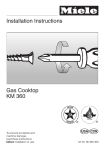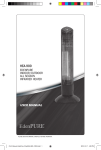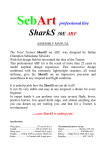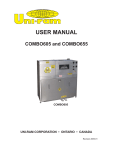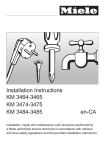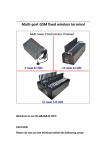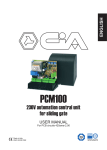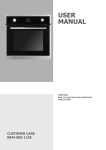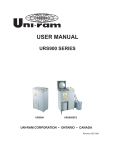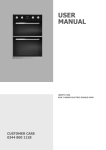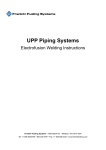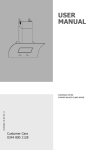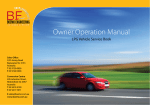Download ALEX 3/4 - Cedtrade.co.uk
Transcript
ALEXANDER BLAST CHILLER/FREEZER ALEX 3/4 INSTRUCTIONS FOR USE AND INSTALLATION 1. GENERAL INFORMATION We recommend you read carefully the owners instructions and user manual, remembering that it is an integral part of this equipment and it must be kept with care. In case of loss or damage of this manual please don’t hesitate to contact your supplier for a replacement specifying the model required. The blast chiller/freezer has been designed and built exclusively for the blast chilling and freezing of food. THE MANUFACTURER DECLINES ANY RESPONSIBILITY FOR DAMAGES RESULTING FROM: • • • • ILLEGITIMATE USE USE OF NON ORIGINAL SPARE PARTS UNAUTHORISED MODIFICATION OF PRODUCT FAILURE TO COMPLY WITH THE INSTRUCTIONS HEREIN ELEMENTARY SAFETY MEASURES • • • • 2. Unplug the unit before performing any kind of work on the electrical parts, contact can cause death Don’t use the appliance with damp or wet hands or feet Unplug before cleaning the appliance Don’t insert any screwdriver, kitchen utensil etc. among the moving components or grills PRELIMINARY CHECKS Upon receiving this product, please immediately check the unit for any damage incurred during transit. Open the packaging and ensure that all the accessories are complete with the unit. If upon inspection, there has been transit damage, immediately inform the driver. All damages arising from the transport of the unit should be reported within 3 working days of receipt. 3. WARRANTY TERMS The product is covered by a 12 month warranty starting from the date of receipt. Before delivery of spare parts under warranty, any damaged or faulty parts must be returned. 4. INSTALLATION The main specifications such as dimensions, power loads etc. are specified on the European Community silver label. The unit must use an electrical socket equipped with an automatic cut-out, in line with local regulations. Make sure also those voltage and power lines are suitable to the motor absorption. 4.1 Positioning The installer must verify the presence of fire prevention regulations, and place the appliance in full obedience of the industrial injuries legislation and the current regulations. The appliance works with an air condenser, so it may be necessary to pay attention to locating it, keeping the sides clear for incoming cooling air. It is also necessary to keep it at least 200mm from walls or other appliances near the exit point for the warm air so as to ensure optimum performance. Avoid placing the appliance in poorly ventilated areas and exposing it directly to sunlight and other heat sources. 4.2 Ambience Generally the refrigerators with air condensing units work with a maximum ambient temperature of 32˚C. The declared performances are not guaranteed in areas of ambient temperature exceeding this. The manufacturer guarantees an IP43 degree of protection (in accordance with CEI 70-1 EN 60529 and IEC529 laws.) The installer will estimate if different ambient conditions require other forms of protection. NOTE Correct Installation: • • • Verify the electrical connections Verify the absorption at working appliance Switch on the appliance and let it reach the desired temperature before loading with food. If the appliance has been transported in an inappropriate way (eg. Non-Vertical or laying on back) wait at least 4 hours before switching it on. The end user must be advised on correct use of the appliance. 4.3 Correct Disposal Correct disposal of this product (Waste Electrical and Electronic Equipment) Applicable in the European Union and other European countries with separate collection systems. This marking shown on the product or its literature, indicates that it should not be disposed of with other household waste at the end of its working life. To Prevent possible harm to the environment or human health from uncontrolled waste disposal, please separate this from other types of waste and recycle it responsibly in line with local regulations. Household users should contact either the retailer from which it was purchased or local authority for details of where and how they may dispose of this unit in an appropriate manner. Business users should contact their supplier and check the terms and conditions of the purchase contract. This product should not be mixed with other commercial wastes for disposal. Penalties may be incurred to the defaulting user for inappropriately disposing of the appliance. 5. CONTROL PANEL Below is the key for the controls relating to the operation of this appliance as shown on the control panel: TIMED BLAST CHILL DEFROST START TIMED BLAST FREEZE TEMP BLAST CHILL DECREASE INCREASE TEMP BLAST FREEZE 6. INSTRUCTIONS FOR THE STARTING OF THE BLAST CHILLING AND FREEZING CYCLES Here, follow the setting instructions for starting the most common functions of the appliance N.B. FOR OPTIMUM FUNCTION OF THE APPLIANCE, REMEMBER TO START AN AUTOMATIC DEFROST AFTER 2/3 CONSECUTIVE BLAST CHILLING/FREEZING CYCLES. SUCH OPERATION CAN BE MADE BY KEEPING THE DOOR OPEN AND PRESSING THE DEFROSTING KEY . THAT SEQUENCE OF CONTROLS WILL FORCE THE APPLIANCE IN AUTO DEFROST MODE. 6.1 Temp Blast Chilling Procedure to use the blast chilling function: 1. Insert the probe into the food 2. Press the TEMP BLAST CHILLING Key 3. Start the working cycle by pressing the START key 4. The blast chilling cycle ends when the temperature reaches +3˚C 5. The unit automatically starts the preservation phase During the blast chilling phase it is always possible to check the probe temperature by pressing the TEMP BLAST CHILLING key. Upon pressing this it will display the probe temperature in Green lighting for 5 seconds. It is also possible to see the amount of time passed from the beginning of the cycle by pressing the TIME BLAST CHILLING KEY. Upon pressing this, the time elapsed will display in Green lighting for 5 seconds. When it is time to remove the food from the blast chiller/freezer, press the START key. Now the appliance is ready for another working cycle. 6.2 Timed Blast Chilling Procedure to use the timed blast chilling function: 1. Press twice the TIMED BLAST CHILLING key 2. Set the desired working time with the INCREASE and DECREASE keys 3. Start the working cycle by pressing the START Key 4. The blast chilling phase ends when it has passed the preset time as length of the chilling phase 5. At the end of this cycle, the appliance will automatically begin the preservation phase During the blast chilling phase it is always possible to check the probe temperature by pressing the TIME BLAST CHILLING key. Upon pressing this it will display the probe temperature in Green lighting for 5 seconds. It is also possible to see the amount of time passed from the beginning of the cycle by pressing the TIME BLAST CHILLING KEY. Upon pressing this, the time elapsed will display in Green lighting for 5 seconds. When it is time to remove the food from the blast chiller/freezer, press the START key. Now the appliance is ready for another working cycle. 6.3 Temp Blast Freezing Procedure to use the blast freezing function: 1. Insert the probe into the food 2. Press the TEMP BLAST FREEZING Key 3. Start the working cycle by pressing the START key 4. The blast chilling cycle ends when the temperature reaches -18˚C 5. The unit automatically starts the preservation phase During the blast freezing phase it is always possible to check the probe temperature by pressing the TEMP BLAST FREEZING key. Upon pressing this it will display the probe temperature in Green lighting for 5 seconds. It is also possible to see the amount of time passed from the beginning of the cycle by pressing the TIME BLAST FREEZING KEY. Upon pressing this, the time elapsed will display in Green lighting for 5 seconds. When it is time to remove the food from the blast chiller/freezer, press the START key. Now the appliance is ready for another working cycle. 6.4 Timed Blast Freezing Procedure to use the timed blast freezing function: 1. Press twice the TIMED BLAST FREEZING key 2. Set the desired working time with the INCREASE and DECREASE keys 3. Start the working cycle by pressing the START Key 4. The blast freezing phase ends when it has passed the preset time as length of the freezing phase 5. At the end of this cycle, the appliance will automatically begin the preservation phase During the blast freezing phase it is always possible to check the probe temperature by pressing the TIME BLAST FREEZING key. Upon pressing this it will display the probe temperature in Green lighting for 5 seconds. It is also possible to see the amount of time passed from the beginning of the cycle by pressing the TIME BLAST FREEZING KEY. Upon pressing this, the time elapsed will display in Green lighting for 5 seconds. When it is time to remove the food from the blast chiller/freezer, press the START key. Now the appliance is ready for another working cycle. 7. ADVICE FOR GOOD USAGE N.B. ATTENTION! The Blast chiller/freezer must not be used as a normal refrigerating appliance. Do NOT insert food with a temperature higher than 70˚C, the controller will indicate an error. It is advisable, for optimum performance of the unit, to chill the chamber by running a full working cycle at least until the preservation temperature is achieved before loading the appliance. Other recommendations to avoid damage to the appliance are as follows: • • • • • Do not leave hot products inside the unit without starting a cycle Start the required cycle as soon as possible after placing the product inside Avoid covering the loaded pans (also with isolating films), the best performances and times are achieved with the maximum quantity of exposed surface area In order to allow better air flow, leave sufficient space between the inserted pans Place the inserted pan on the supplied shelves and not directly on the floor of the unit REMBER PERIODICALLY TO CHECK THE EVAPORATOR TRAY AT THE BOTTOM OF THE UNIT AND EMPTY IT REGULARLY 7.1 FEATURES OF THE PRODUCT TO TREAT Considering that the referred timings of the cycles start from +70˚C (Chilling cycle from +70˚C to +3˚C, Freezing cycle from +70˚C to -18˚C. • Do not leave the food for a long time in ambient temperature, the higher the humidity lost from the product, the lower the preserved softness will be. • Do not insert the product at a temperature higher than +70˚C N.B PULL OUT THE PROBE FROM THE TREATED FOOD, HOLDING IT BY THE RIGID HANDLE AND NOT PULLING ON THE CABLE. DOING THIS CAN CAUSE THE CABLE TO SNAP AND IT WILL NOT BE REPLACED UNDER WARRANTY 8. ROUTINE MAINTENANCE In order to adequately maintain the appliance, all users must adhere to the elementary safety rules as quoted in paragraph 1. GENERAL INFORMATION. It is also compulsory to not remove the safety devices and protections in place during routine maintenance. Failure to adhere to this will result in the manufacturer declining all responsibility for any damages or accidents arising from non-compliance. The appliance must be cleaned daily in order to guarantee the best quality and sanitary condition of the treated products. Use warm soapy water and nonabrasive cleaning agents, rinsing off with a soft cloth or sponge. N.B. NO SHARP OR INSTRUMENTS FOR SCRAPING, NO SOLVENTS OR DILUTENTS! For better air circulation, also keep the condensing unit clean, removing dust etc. from the fins. To reach the condensing unit, you must first remove the plug from the socket and unscrew the front panel being careful not to disrupt the electrical connections by pulling. It is advised to use a vacuum cleaner to remove dust. Do not scrape with sharp or abrasive objects. Once complete, reassemble the front panel, replacing the screws. The evaporated water produced by defrosting goes into a tank at the bottom of the unit. In case of certain maintenance and repair requirements, it is also possible to remove the rear and lateral panels if necessary. Such operations should only be carried out by a suitably qualified person, and only after having disconnected the unit from the mains electricity. 9. ALARMS LIST (TROUBLESHOOTING) CODE ER1 PROBLEM Failure of chamber probe ER2 Failure of product probe ER3 ER4 Failure of evaporator probe (only if enabled) Failure of condenser probe AL1 AL2 Open door alarm High pressure alarm AL3 High temperature condensing alarm (only if enabled) Not inserted pin AL4 SOLUTION Check connections and functioning of the chamber probe Check connections and function of the product probe Check connections and functioning of evaporator probe Check connections and functioning of the condenser probe Close the door Remove the alarm cause, turn off and switch back on the appliance Wait for the condenser to drop in temperature Check the pin insertion









